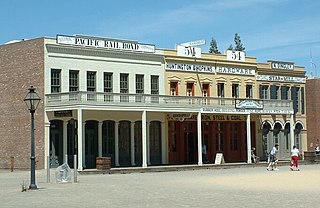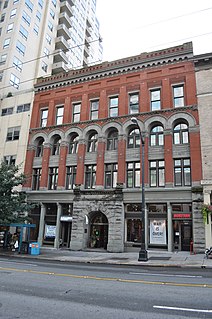
Mattoon is a city in Coles County, Illinois, United States. The population was 18,555 as of the 2010 census. The city is home to Lake Land College and has close ties with its neighbor, Charleston. Both are principal cities of the Charleston–Mattoon Micropolitan Statistical Area.

The Reliance Building is a skyscraper located at 1 W. Washington Street in the Loop community area of Chicago, Illinois. The first floor and basement were designed by John Root of the Burnham and Root architectural firm in 1890, with the rest of the building completed by Charles B. Atwood in 1895. It is the first skyscraper to have large plate glass windows make up the majority of its surface area, foreshadowing a design feature that would become dominant in the 20th century.

The University Cottage Club or simply Cottage Club is one of eleven current eating clubs at Princeton University, in Princeton, New Jersey, United States. It is also one of the six bicker clubs, along with The Ivy Club, Tiger Inn, Cap and Gown Club, Cannon Club and Tower Club.

The Magill House is a historic hotel located at 100 N. Center St. in Clinton, Illinois. Construction on the building began in 1872 and was completed in 1873. The hotel was built in order to entice the Illinois Central Railroad to move the headquarters of its Springfield Division to Clinton; the effort was successful, as the railroad moved to Clinton in the late 1870s. From its construction through the mid-20th century, the hotel was considered the finest in Clinton, and housed both Illinois Central employees and travelers on the railroad. The hotel transitioned to an apartment hotel in the 1970s, and after the late 1980s it declined and ultimately closed.

Mattoon is an Amtrak intercity train station in Mattoon, Illinois, United States. The station is a flag stop on the City of New Orleans route, served only when passengers have tickets to and from the station. It is a regular stop for the Illini and Saluki.

Pullman National Monument, also known as The Pullman District and Pullman Historic District, is located in Chicago and was the first model, planned industrial community in the United States. The district had its origins in the manufacturing plans and organization of the Pullman Company, and became one of the most well-known company towns in the United States, as well as the scene of the violent 1894 Pullman strike. It was built for George Pullman as a place to produce the famous Pullman sleeping cars.

Amboy station is a former rail station in the city of Amboy, Lee County, Illinois, United States. The building was constructed as a headquarters building for the Illinois Central Railroad as well as a public train station for the fledgling city of Amboy in 1876. It was designed by railroad staff architect James Nocquet after a fire destroyed the original Illinois Central offices on the site. The building was added to the U.S. National Register of Historic Places in 1992 as the Amboy Illinois Central Depot.

The Nachusa House is a former hotel building in Dixon, Illinois, United States along Galena Avenue. The building was constructed in 1853 and operated continuously as a hotel until 1988. It underwent many alterations during the time it operated as a hotel. Following its period as a hotel the five-story mansard roofed building fell into disrepair and was nearly demolished in 1997. The building was restored by the Illinois Housing Development Authority and a Chicago developer at a cost of US$3.2 million and renovated into affordable housing for senior citizens. During its height the Nachusa House was a popular stop along rail and stagecoach lines and was a known layover for Abraham Lincoln. The Nachusa House was added to the U.S. National Register of Historic Places in 1983.

Central House is an 1860s hotel building located in the 800-person village of Orangeville, in Stephenson County, Illinois, United States. The building was built by Orangeville founder John Bower and operated as a hotel from its construction until the 1930s, when it was converted for use as a single family residence. The three-story building was the first commercial brick structure in downtown Orangeville. Architecturally, the building is cast in a mid-19th-century Italianate style. Central House was added to the U.S. National Register of Historic Places in 1999.

The Big Four Building is a historic 19th-century building in Downtown Sacramento, California. It is now located within Old Sacramento State Historic Park and the Old Sacramento National Historic District.

The Milner Arms Apartments, originally known as the Hotel Stevenson, is a high rise building located at 40 Davenport Street in Midtown Detroit, Michigan; it was listed on the National Register of Historic Places in 1997. It is adjacent to, but not part of, the Cass-Davenport Historic District.

There are nine historic districts in Meridian, Mississippi. Each of these districts is listed on the National Register of Historic Places. One district, Meridian Downtown Historic District, is a combination of two older districts, Meridian Urban Center Historic District and Union Station Historic District. Many architectural styles are present in the districts, most from the late 19th century and early 20th century, including Queen Anne, Colonial Revival, Italianate, Art Deco, Late Victorian, and Bungalow.

The Hotel Aurora, also known as Aurora Hotel, is a hotel built in 1917 on Stolp Island in Aurora, Illinois.

The Grand Pacific Hotel is a historic building in Seattle, Washington located at 1115-1117 1st Avenue between Spring and Seneca Streets in the city's central business district. The building was constructed in 1890 [Often incorrectly cited as 1898] during the building boom that followed the Great Seattle Fire of 1889. Though designed as an office building, the Grand Central had served as a Single room occupancy hotel nearly since its construction, with the Ye Kenilworth Inn on the upper floors during the 1890s. The hotel was refurnished and reopened in 1900 as the Grand Pacific Hotel, most likely named after the hotel of the same name in Chicago that had just recently been rebuilt. It played a role during the Yukon Gold Rush as one of many hotels that served traveling miners and also housed the offices for the Seattle Woolen Mill, an important outfitter for the Klondike.

The Bloomington freight station is a historic train station in downtown Bloomington, Indiana, United States. Constructed in the early twentieth century, it has endured closure and a series of modifications to survive to the present day, and it has been declared a historic site. Used only occasionally for many years, it is one of the most important buildings in a large historic district on the city's west side.

The Illinois Traction Building, located at 41 E. University Ave. in Champaign, Illinois, was the headquarters of the Illinois Traction System, an interurban railroad serving Central Illinois. Built in 1913, the building held the railway's offices and served as the Champaign interurban station until 1936; it later housed the offices of the Illinois Power Company, which descended from the Illinois Traction System. Architect Joseph Royer planned the building in a contemporary commercial design. The building was added to the National Register of Historic Places on September 20, 2006.

The Railway Express Agency Building was a historic building located at 1804 Western Avenue in Mattoon, Illinois. The building was constructed in 1918 to serve as the Mattoon office of the Railway Express Agency. The Railway Express Agency provided rail express shipping services to Mattoon's citizens, allowing them to ship money and packages along Mattoon's two major railways, the Illinois Central Railroad and Cleveland, Cincinnati, Chicago and St. Louis. The agency formed in 1917, when the federal government ordered that all existing express services consolidate into a single service; this measure ensured consistent shipping of goods during World War I. The agency shipped goods to and from Mattoon until 1964, when the Big Four went bankrupt; the building served as a freight depot until 1971.

Hotel Lester-Lester Cafe, also known as the Dodge House-Long Branch, is a historic building located in Mason City, Iowa, United States. Its construction, completed in 1915, was a project undertaken by local real estate developer Meir Wolf. It was built as a two-story building a block away from the passenger and freight depots of the Chicago and North Western Railroad and the Chicago Great Western Railway. The building was meant to be used as a railroad hotel so passengers and rail employees would not have to travel the six to eight blocks to the hotels downtown. It is the only remaining railroad hotel left in Mason City. Hotel guests stayed in the 29 rooms on the second floor, and three commercial spaces on the first floor were occupied by a variety of restaurants, grocery stores and barbershops. Its most famous guest was track star Jesse Owens, who was in town in December 1937 for a basketball exhibition. He could not stay at the other hotel's in town because of his race. In 1975 the hotel's name was changed to the Dodge House and the Long Branch Saloon occupied the space that had previously housed a cafe. By that time it was largely used as a rooming house, and it was used to house the homeless. The building was listed on the National Register of Historic Places in 2002.

The Brazelton House Hotel is a historic building located in Mount Pleasant, Iowa, United States. William P. Brazelton was an early leader in the city's development. He owned the Brazelton Banking House and he was one of the directors of the Brazelton House Company, which built the hotel. It is not clear, specifically, why the hotel bears his family name. The construction of the hotel in 1856 coincided with a building boom in Mount Pleasant with the extension of the Burlington and Missouri River Railroad into town. It was built with the belief that Mount Pleasant would need a large first class hotel, but it had financial problems from the beginning and went through a series of owners until it no longer functioned as a hotel about 1970. The building was listed on the National Register of Historic Places in 1986. In 2015 the upper floors were converted into apartments while the main floor continued to house retail businesses.

The Covent Hotel is a historic residential hotel at 2653-65 N. Clark Street in the Lincoln Park neighborhood of Chicago, Illinois. Built in 1915, the hotel was one of the many residential hotels constructed in early twentieth century Chicago to house the city's growing single working-class population. Covent Hotel was a rooming hotel, a subtype of residential hotel that exclusively offered single rooms with few amenities. Like many rooming hotels, the Covent Hotel housed commercial space on its first floor, including a restaurant to provide convenient nearby meals for its residents. Architect Frank E. Davidson designed the Classical Revival building, which features brick piers and a parapet.






















